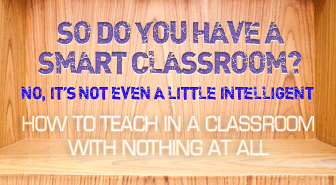“So how are you keeping up on all of the technology in your classroom?” the woman from staff development recently asked me at a meeting. “Would you like to sign up for any training?” “For what?” I asked. “Do you mean the overhead projector?” “No-o-o,” she said hesitantly. “Don’t you have a smart classroom?”
A smart classroom. It begs the question of what we had before. I thanked the woman from staff development politely and told her I thought I’d be all right.
There is a general perception that our classrooms are loaded with the latest gadgets—smart boards and Ipads and Nooks. And if it’s not being incorporated into the curriculum, it’s because teachers are too stubborn, or stupid, to learn it.
However, if all that technology is indeed out there, it has yet to find its way to most of the classrooms I have contact with. Humanities in general, ESL in particular, is not high on the spending priorities for most educational institutions. We ESL educators have a different technology problem: how to cope with technology several millennia old. Socrates might have taught in my classrooms of plain brick walls and chalkboards.
So if indeed the most advanced technology in your classroom is the overhead, how do you teach with the existing resources, especially with a student population and even teacher population increasingly used to more advanced technology?

How to Teach in a Classroom with Nothing at All
-
1
Weave the Existing Technology into the Curriculum
It is possible to use existing resources to their fullest if you use your creativity as well. I really honed my artistic skills—or rather, developed ones I didn’t know I had—when I became an ESL teacher and found myself having to draw clowns and carriages to demonstrate vocabulary in students’ textbooks, vocabulary without accompanying pictures or definitions. Another teacher I’ve worked with will, instead of developing a PowerPoint show because of the lack of needed technology in her room, will instead use her overhead projector and make a set of slides, quickly moving between them—in effect, simulating a PowerPoint show. Before the first day of school, all teachers should assess the existing “tools” in the classroom and how the curriculum will work with it or how it can be made to work.
-
2
Beg, Borrow, and Steal More Advanced Technology
If you decide that the tools in your classroom are indeed not sufficient, there are options. Nearly everyone has at least one—maybe several—old or unused electronic devices in their homes. E-waste pick-ups, in which city trucks come by for special pick-ups of electronic garbage, have become common. Maybe some of this material—perhaps in your own or a neighbor’s house—still has a life. There is a classroom, I’m sure, that can use my old Mac desktop, two boom boxes, and a laptop. If you hold your own “e-waste” drive to benefit your class, you might be surprised at what you receive. Often people will dump electronics not because there is anything wrong with them but simply because they are a year or two old. In addition, teachers can often actually use old technology—boom boxes that play cassette tapes, useless to owners of iPods, actually can be used by ESL teachers who work with a curriculum that is still in part on language tapes.
-
3
Gain Support
As you are on this quest of bringing your room into the 21st century, people are going to notice you. Some will become your supporters. They may show their support with simple words of advice to more extensive phone calls and offers of equipment. Their motives are usually straightforward: people like to think that they are helping students and schools. Any help should be gratefully accepted and acknowledged, perhaps with a list of supporters in your class on your class website.
-
4
Research
Your mission might at some point expand beyond a simple local, informal effort and become formal and extensive. For example, if you decide your class would benefit from iPads or a Smartboard, this has gone beyond the level of your school site or neighborhood. It’s time to do some research on what resources are out there for teachers who want to modernize their classrooms. There are agencies out there that will support this mission and funding to give, but they have to be located. You might start locally and see, for example, if the nearby Apple computer plant makes donations to schools. You can also search the web to see about possibilities. Even in recessionary times, there are still organizations making donations of material and monetary support!
-
5
Write a Grant
Finally, if you find an agency that supports your specific need, you might decide to write a grant. Study the company’s website and guidelines for giving grants: many have specific deadlines and their own forms to fill out, for example. If you decide to go ahead with the grant, keep in mind some general principles: be as specific as possible on what you are requesting, how it will be used, when your goals will be accomplished and why you are a strong candidate for the grant. There are even grant writing workshops available at little or no cost online. In addition, your district might offer such workshops.
It isn’t easy, teaching in a classroom with nothing at all.
However, with persistence and creativity, the teacher can make “nothing” work for her or can become a trailblazer, taking her class from “nothing” to fully equipped for the new millennium.
Is your classroom “smart” enough? If not, what are ways you deal with it?
P.S. If you enjoyed this article, please help spread it by clicking one of those sharing buttons below. And if you are interested in more, you should follow our Facebook page where we share more about creative, non-boring ways to teach English.







